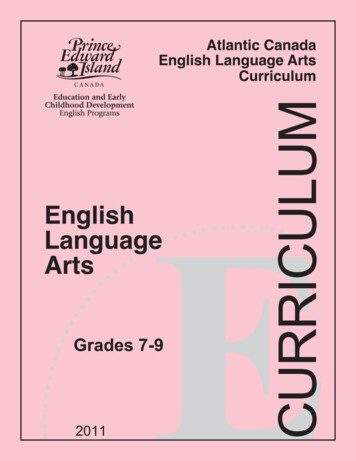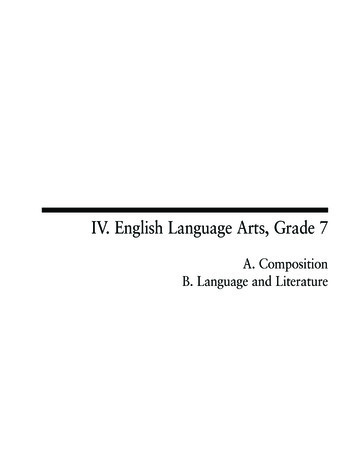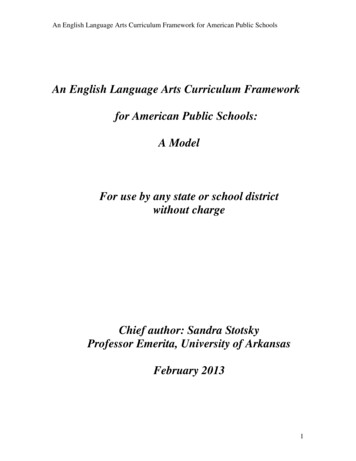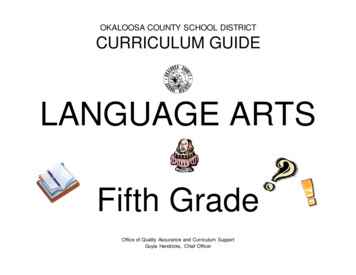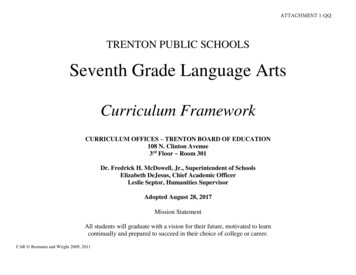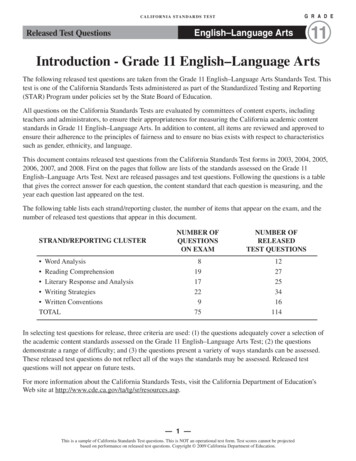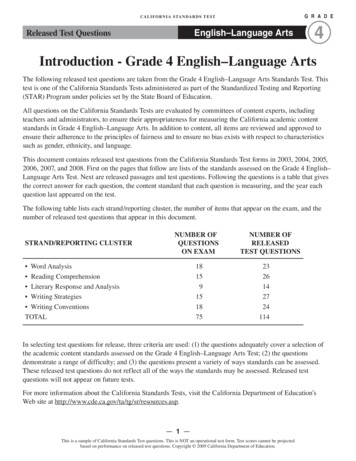
Transcription
VII. English Language Arts, Grade 8
Grade 8 English Language Arts TestThe spring 2018 grade 8 English Language Arts test was a next-generation assessment that was administered in two formats: acomputer-based version and a paper-based version. The test included both operational items, which count toward a student’s score,and matrix items. The matrix portion of the test consisted of field-test and equating questions that do not count toward a student’sscore.Most of the operational items on the grade 8 ELA test were the same, regardless of whether a student took the computer-basedversion or the paper-based version. In some instances, the wording of a paper item differed slightly from the computer-based version.In places where a technology-enhanced item was used on the computer-based test, that item was typically replaced with one or morealternative items on the paper test. These alternative items sometimes assessed the same standard as the technology-enhanced item, orother standards from the same reporting category.This document displays the paper-based versions of the 2018 operational items that have been released. The computer-basedversions of the released items are available on the MCAS Resource Center website at mcas.pearsonsupport.com/released-items.Test Sessions and Content OverviewThe grade 8 ELA test was made up of two separate test sessions. Each session included reading passages, followed by selectedresponse and essay questions. On the paper-based test, the selected-response questions were multiple-choice items, in which studentsselect the correct answer from among several answer options.Standards and Reporting CategoriesThe grade 8 ELA test was based on grades 6–12 learning standards in three content strands of the Massachusetts CurriculumFramework for English Language Arts and Literacy (2017), listed below. Reading Writing LanguageThe Massachusetts Curriculum Framework for English Language Arts and Literacy is available on the Department website atwww.doe.mass.edu/frameworks/.ELA test results are reported under three MCAS reporting categories, which are identical to the three framework content strandslisted above.The tables at the conclusion of this chapter provide the following information about each released and unreleased operational item:reporting category, standard(s) covered, item type, and item description. The correct answers for released selected-response questionsare also displayed in the released item table.Reference MaterialsDuring both ELA test sessions, the use of bilingual word-to-word dictionaries was allowed for current and former English learnerstudents only. No other reference materials were allowed during any ELA test session.106
Grade 8 English Language ArtsThis session contains 18 questions.DirectionsRead each passage and question carefully. Then answer each question as well as youcan. You must record all answers in your Student Answer Booklet.For most questions, you will mark your answers by filling in the circles in your StudentAnswer Booklet. Make sure you darken the circles completely. Do not make any marksoutside of the circles. If you need to change an answer, be sure to erase your firstanswer completely.Some questions will ask you to write a response. Write each response in the spaceprovided in your Student Answer Booklet. Only responses written within the providedspace will be scored.107
English Language Arts The American Civil War was a conflict between the southern states, calledthe Confederacy, and the northern states, known as the Union or the UnitedStates. The war was caused, in part, by a disagreement over whether whiteAmericans had the right to own African Americans as slaves. Read the twoexcerpts about an important meeting that happened during the Civil War, andthen answer the questions that follow.In “Waiting for Mr. Lincoln,” Frederick Douglass, an influential opponent of slavery,hopes to meet with Abraham Lincoln, the President of the United States.Waiting for Mr. Lincolnby Russell Freedman1 Heads turned when Frederick Douglass walked into the White House on themorning of August 10, 1863. It was still early, but the waiting area leadingto Abraham Lincoln’s office was crowded with politicians, officials, patronageseekers, and citizens of all kinds seeking an audience with the president.2 Douglass was the only black man among them. The others seemedsurprised to see him, and some were none too pleased.3 Lincoln tried to meet with as many callers as he possibly could each day.He said he enjoyed his “public opinion baths” and found them a useful wayto find out what people were thinking. When first elected, he had refusedto limit his visiting hours. “They do not want much,” he said of the throngsof citizens waiting to see him one day, “and they get very little. . . . Iknow how I would feel in their place.”4 But the crowds became unmanageable. People showed up before breakfastand were still waiting to see him late at night. At times, even U.S. senatorshad to wait a week or more to speak with the president. As his work piledup, Lincoln realized that he had to restrict his visiting hours. He saw callersfrom ten o’clock in the morning till one in the afternoon. Priority was givento cabinet members and congressmen; if any time remained, ordinarycitizens were admitted.5 It wasn’t easy to see the president. Not everyone got in.6 Douglass handed his calling card to a clerk and looked around for anempty chair. None was available, so he found a place to sit on the stairwayleading to Lincoln’s office. The stairs were filled with other men hoping fora moment with the nation’s chief executive.7 Douglass had no appointment. He had no idea how long he might haveto wait, or even if he would be granted an interview. By meeting with thepresident, he hoped “to secure just and fair treatment” for the thousands of108
English Language Arts black troops who had enlisted in the Union army and were now fighting forthe North in America’s Civil War.8 When the war began, federal law prohibited blacks from serving in the army.But as the fighting continued, with mounting casualties and no decisivevictories, the North finally allowed African Americans to enlist. Black soldiersfought with distinction, but they were paid only half as much as whitesoldiers and were not being promoted for outstanding service. Worse, blackprisoners of war were being executed or enslaved by their Southern captors.9 Douglass had come to Washington to “lay the complaints of my peoplebefore President Lincoln.” At forty-five, formally dressed for his visit, hewas a commanding figure, taller than most men, with a powerful athlete’sbuild, graying hair, penetrating brown eyes, and a carefully trimmed beard.A former slave, he had escaped to freedom and become a famous author,newspaper editor, and abolitionist. He had spent his career as a free mandemanding that slavery be abolished in America and equal rights extendedto whites and blacks alike.10 Douglass and Lincoln had never met, but they had some things in common.They had both risen from poverty and obscurity to international prominence.Both were self-educated. Lincoln, born dirt poor, had less than a year offormal schooling. Douglass, born a slave, wasn’t permitted to go to school.He taught himself to read and write in secret, hiding the few books he wasable to get his hands on. And in fact the two men had read and studiedsome of the same books.11 Even so, in the year 1863 it required plenty of “nerve,” as Douglass put it,for a black man to walk unannounced into the White House and request anaudience with the president.12 Millions of blacks were still enslaved on farms and plantations in theConfederate South. In the North, African Americans were free but weredenied many rights. . . .13 “The distance between the black man and the white American citizen wasimmeasurable,” Douglass later recalled. “I was an ex-slave, identified with adespised race, and yet I was to meet the most exalted person in this greatrepublic. . . . I could not know what kind of reception would be accordedme. I might be told to go home and mind my business. . . . Or I might berefused an interview altogether.”14 He was determined to wait.“Waiting for Mr. Lincoln” by Russell Freedman, from Abraham Lincoln and Frederick Douglass: The Story Behind anAmerican Friendship. Copyright 2012 by Russell Freedman. Reprinted by permission of Clarion Books, an imprintof Houghton Mifflin Harcourt Publishing Company.109
English Language Arts In this excerpt from Life and Times of Frederick Douglass, Douglass describes hismeeting with Abraham Lincoln.from Life and Times of Frederick Douglassby Frederick Douglass1 I shall never forget my first interview with this great man. I wasaccompanied to the executive mansion and introduced to President Lincolnby Senator Pomeroy. The room in which he received visitors was the onenow used by the President’s secretaries. I entered it with a moderateestimate of my own consequence, and yet there I was to talk with, andeven to advise, the head man of a great nation. Happily for me, therewas no vain pomp and ceremony about him. I was never more quickly ormore completely put at ease in the presence of a great man than in thatof Abraham Lincoln. He was seated, when I entered, in a low armchair withhis feet extended on the floor, surrounded by a large number of documentsand several busy secretaries. The room bore the marks of business, andthe persons in it, the President included, appeared to be much over-workedand tired. Long lines of care were already deeply written on Mr. Lincoln’sbrow, and his strong face, full of earnestness, lighted up as soon as myname was mentioned. As I approached and was introduced to him hearose and extended his hand, and bade me welcome. I at once felt myselfin the presence of an honest man—one whom I could love, honor, andtrust without reserve or doubt. Proceeding to tell him who I was and whatI was doing, he promptly, but kindly, stopped me, saying: “I know whoyou are, Mr. Douglass; Mr. Seward has told me all about you. Sit down.I am glad to see you.” I then told him the object of my visit: that I wasassisting to raise colored troops; that several months before I had beenvery successful in getting men to enlist, but that now it was not easy toinduce the colored men to enter the service, because there was a feelingamong them that the government did not, in several respects, deal fairlywith them. Mr. Lincoln asked me to state particulars. I replied that therewere three particulars which I wished to bring to his attention. First, thatcolored soldiers ought to receive the same wages as those paid to whitesoldiers. Second, that colored soldiers ought to receive the same protectionwhen taken prisoners, and be exchanged as readily and on the same termsas any other prisoners, and if Jefferson Davis should shoot or hang coloredsoldiers in cold blood the United States Government should, without delay,retaliate in kind and degree upon Confederate prisoners in its hands. Third,when colored soldiers, seeking the “bubble reputation at the cannon’smouth,” performed great and uncommon service on the battlefield, theyshould be rewarded by distinction and promotion precisely as white soldiersare rewarded for like services.110
English Language Arts 2 Mr. Lincoln listened with patience and silence to all I had to say. He wasserious and even troubled by what I had said and by what he himself hadevidently before thought upon the same points. He, by his silent listeningnot less than by his earnest reply to my words, impressed me with thesolid gravity of his character.3 He began by saying that the employment of colored troops at all was agreat gain to the colored people; that the measure could not have beensuccessfully adopted at the beginning of the war; that the wisdom ofmaking colored men soldiers was still doubted; that their enlistment was aserious offense to popular prejudice; that they had larger motives for beingsoldiers than white men; that they ought to be willing to enter the serviceupon any condition; that the fact that they were not to receive the samepay as white soldiers seemed a necessary concession to smooth the way totheir employment at all as soldiers, but that ultimately they would receivethe same. On the second point, in respect to equal protection, he said thecase was more difficult. Retaliation was a terrible remedy, and one which itwas very difficult to apply; that, if once begun, there was no telling whereit would end; that if he could get hold of the Confederate soldiers who hadbeen guilty of treating colored soldiers as felons he could easily retaliate,but the thought of hanging men for a crime perpetrated by others wasrevolting to his feelings. He thought that the rebels themselves would stopsuch barbarous warfare; that less evil would be done if retaliation werenot resorted to and that he had already received information that coloredsoldiers were being treated as prisoners of war. In all this I saw the tenderheart of the man rather than the stern warrior and commander-in-chiefof the American army and navy, and, while I could not agree with him, Icould but respect his humane spirit.4 On the third point he appeared to have less difficulty, though he didnot absolutely commit himself. He simply said that he would sign anycommission to colored soldiers whom his Secretary of War should commendto him. Though I was not entirely satisfied with his views, I was so wellsatisfied with the man and with the educating tendency of the conflict thatI determined to go on with the recruiting.Life and Times of Frederick Douglass by Frederick Douglass. In the public domain.111
English Language Arts qWhat is the most likely reason that the author of “Waiting for Mr. Lincoln”included paragraphs 1 and 2?A. to show the impatience of people in the White House waiting areaB. to suggest that prejudice existed even in the White House waiting areaC. to indicate the special treatment provided in the White House waiting areaD. to illustrate the physical discomfort felt by visitors in the White Housewaiting areawWhich sentence best states a central idea of “Waiting for Mr. Lincoln”?A. Douglass’s belief in the importance of his cause led to his desire to meetwith Lincoln.B. Lincoln showed an unusual admiration for Douglass because of their similarbeginnings.C. Lincoln’s overwhelming responsibilities prevented him from making significantdecisions.D. Douglass believed that the best way to improve society was to trust thewisdom of powerful leaders.112
English Language Arts eIn Life and Times of Frederick Douglass, how did Douglass mainly present hisclaim that the United States government acted unfairly toward African Americansoldiers?A. by criticizing society in general to appeal to Lincoln’s sense of justiceB. by referring to his personal history in order to inspire Lincoln’s sympathyC. by offering an argument and dismissing the counterargument of theoppositionD. by making specific recommendations and providing suggestions for resolvingproblemsrWhich sentence best describes a difference in the points of view of the twoexcerpts?A. “Waiting for Mr. Lincoln” presents a favorable interpretation of the meeting,while Life and Times of Frederick Douglass is more critical.B. “Waiting for Mr. Lincoln” provides only Lincoln’s position, while Life and Timesof Frederick Douglass is told from Douglass’s perspective.C. “Waiting for Mr. Lincoln” is told from a historian’s perspective, while Life andTimes of Frederick Douglass is told from a participant’s perspective.D. “Waiting for Mr. Lincoln” shares the memories of someone who worked forLincoln, while Life and Times of Frederick Douglass presents the reflections ofan observer.113
English Language Arts tBased on the information in the excerpts, which position is most likely sharedby both Lincoln and Douglass?A. They both believe that a Union victory is imminent.B. They both approve of treating Confederate prisoners harshly.C. They both approve of allowing African Americans to fight in the war.D. They both believe that African Americans should enlist regardless of thecircumstances.yWhich sentence best describes how “Waiting for Mr. Lincoln” helps the readerunderstand Life and Times of Frederick Douglass ?A. “Waiting for Mr. Lincoln” identifies disputes that are settled in Life and Timesof Frederick Douglass.B. “Waiting for Mr. Lincoln” lists facts that disprove opinions offered in Life andTimes of Frederick Douglass.C. “Waiting for Mr. Lincoln” provides definitions for key terms used in Life andTimes of Frederick Douglass.D. “Waiting for Mr. Lincoln” provides background information for the eventsportrayed in Life and Times of Frederick Douglass.114
English Language Arts uRead the dictionary entry for the word consequence.consequence: n. 1. result 2. relation between cause and effect 3. importance4. logical conclusionRead the sentence from paragraph 1 of Life and Times of Frederick Douglass.I entered it with a moderate estimate of my own consequence, and yet there Iwas to talk with, and even to advise, the head man of a great nation.Which meaning applies to the word consequence as it is used in the sentence?A. definition 1B. definition 2C. definition 3D. definition 4115
English Language Arts iPart ABased on Life and Times of Frederick Douglass, how did President Lincoln mostlikely feel about the points Frederick Douglass made regarding the treatment ofAfrican American troops in the Union army?A. hopefulB. enragedC. defensiveD. concernedPart BWhich detail from the excerpt best supports the answer to Part A?A. “He was serious and even troubled by what I had said. . . .” (paragraph 2)B. “. . . in respect to equal protection, he said the case was more difficult.”(paragraph 3)C. “Retaliation was a terrible remedy, and one which it was very difficult toapply; that, if once begun, there was no telling where it would end. . . .”(paragraph 3)D. “. . . I determined to go on with the recruiting.” (paragraph 4)116
English Language Arts For this question, you will write an essay based on the passage(s). Write youressay in the space provided in your Student Answer Booklet. Your writingshould:o Present and develop a central idea. Provide evidence and/or details from the passage(s). Use correct grammar, spelling, and punctuation.Based on both “Waiting for Mr. Lincoln” and Life and Times of FrederickDouglass, write an essay explaining whether Frederick Douglass and AbrahamLincoln were effective leaders. Be sure to use information from both excerpts todevelop your essay.117
English Language Arts In this passage from the short story “Deep Water,” the narrator, Sonny, has been livingwith his aunt, uncle, and cousin Keo in Hawaii, when his dad comes to visit. Read thepassage, and then answer the questions that follow.from “Deep Water”by Graham Salisbury1 Keo was alone in the cove, floating on one of the tubes. Small waves fromthe skiff rocked him as we passed by. Dad let me out near shore andheaded back over to the small boat landing.2 Keo rolled off the tube and swam out into the cove, out to the deepestpoint. “Come on out,” he yelled.3 I stared back at him, my arms hanging at my sides like old frayed rope.4 “Chicken,” he shouted. “Buk-buk-buk-bu-gock!”5 The ocean rose to my knees, my waist, then my chest, as I slowly wadedin. When it reached my chin I started swimming, madly kicking and clawingat the ocean. Water exploded all around me, splashing clumsily over myface and blurring my vision. I aimed my chin to the sky and thrashed outto Keo, swimming past him, circling him, then heading back to the beach. Icaught a glimpse of Dad watching from the pier.6 Keo pawed at the water when he swam, too, but easily, without splashing.“Let’s dive to the bottom,” he said.7 I didn’t answer. I barely made it back to shore.8 A half hour later, Dad came down and sat next to me on the sand. Keowas out in the water, hanging over the edge of one of the inner tubes,motionless, as if asleep.9 “You did a good job out there today, Sonny,” Dad said, pointing out to theharbor with his chin. Then, after a moment of silence, he added, “I’m proudof you.”10 Keo looked up and saw us, and started kicking in to shore.11 Dad stood, as if shaken out of a daydream. “It’s time for a couple ofchanges,” he said. “Tell Keo to come, we’re going for a ride.”12 Dad walked over to his Jeep while Keo came up from the water, holding thedripping black tube over his shoulder.118
English Language Arts 13 Dad drove up the rocky driveway to our house, dust rising behind the Jeepand spreading into the dry trees. Aunty Pearl strolled out onto the porchwith her black hair pulled behind her head and curled into a tight knot. Shewaved down to us as we bounced into the yard, her small hand almost loston an arm as thick as my stomach. She looked exactly like the old picturesof Hawaiian queens, wide and tall, draped in full-length muumuus, withhuge bare feet as tough as coconut husks. If an orchid was beautiful, thenAunty Pearl was a thousand of them put together.14 Keo’s scruffy dogs, Bullet and Blossom, set off a racket of barking. AuntyPearl shushed them by clapping her hands.15 Off to the right and slightly downhill Uncle Harley’s icehouse stood like ahuge, windowless box, almost half the size of the main house. He made icefor boats in there, and kept fish before trucking them over to the marketon the other side of the island. A small, fenced-in pigpen with shady,corrugated iron shelters flowed off the uphill side, big enough for three orfour good-sized pigs.16 The dogs leaped at us as we drove up to the house. Keo jumped out ofthe Jeep. “Come on,” he said. “Let’s go see the pigs.”17 I started running after him.18 “Sonny, wait,” Dad called. “Come up to the house for a minute.” Keo kepton going without turning back.19 Aunty Pearl gave us both a hug. It had only been a few hours since I’dseen her, but still she crushed me to her as if I’d been gone a month.She frowned at Dad. “So what are you doing up here in the middle of aperfectly good fishing day?”20 Dad looked down at me and rubbed his hand over my head, then put hisarm on my shoulder. “I think I can handle it now, Pearl.”21 Aunty Pearl put her hand to her cheek, then hugged us again, and startedcrying. She couldn’t talk for a few minutes, because she would start cryingevery time she tried. Finally, she motioned us into the house.22 Keo started walking back toward us kicking an old can.23 Dad and I followed Aunty Pearl to the room that Keo and I shared. Ithought I knew what Dad was saying, but I didn’t want to think about it incase it wasn’t true. Then he and Aunty Pearl started taking my clothes outof the dresser.24 Keo burst into the room. “Hey, what’s going on?”119
English Language Arts 25 Aunty Pearl put her arm around him and pulled him up close. “Sonny’sgoing home, Keo—to live down by the beach with his father.” Then sheturned to me. “But you’ll be back for lots of visits, won’t you, Sonny?”26 I nodded, but must have looked as if I weren’t sure, because Aunty Pearlpulled Keo in closer, and started crying again.27 Dad’s old wooden house stood up on stilts, with three or four feet betweenthe floor and the ground. “To keep rats and mongooses out,” he’d told me.28 Kiawe and coconut trees surrounded the long, rectangular yard andswooped up behind us to the road that ran along the coast from Kailuato Keauhou. Dad parked the Jeep on the grass, his five dogs whining andwagging their tails as we pulled up to the house.29 “You can have my room,” Dad said as we walked in. It was the onlybedroom. Dad nodded toward the big couch in the front room, the placeI always slept when I came to stay for a day or two. “I like to sleep outhere, anyway,” he said.30 Except for the few things I’d brought with me, nothing in the place wasmine. But there was nothing I owned, or could think of owning, that Iwouldn’t have given up to be right there with Dad. Now, and forever, onlyone thin wall would stand between his bed and mine.31 “Before we unpack your things,” Dad said, dropping the cardboard boxof clothes on the kitchen table, “let’s go down to the ocean, maybe takea quick swim. It’s hotter than a dump fire around here.” I’d had enoughswimming that day, but I didn’t mind.32 I followed him down the porch stairs and out across the grass to the water.You could look out and see the horizon, miles and miles away, with onlythe clean, blue and turquoise expanse of ocean between the yard and theend of the world. Dad’s dogs followed, then trotted out ahead, sniffingeverything in sight as if they’d never been there before.33 The shoreline was mostly lava, with a few good-sized sandy patches nestledaround small tidal pools. Dad and I picked our way out over the rocks tothe water, which sparkled under the late afternoon sky. Small waves hissedin and surrounded us as we eased into the ocean, Dad leading the way,and me trailing behind, turning the water white as I churned through it.34 I suddenly realized that I was swimming—out over my head, in deep water.I tried to keep up with Dad, but got tired and had to go back to shore.35 The powdery sand patches were hot and comforting. I sat down in one andstared back out at Dad, now making long, quiet dives to the bottom.120
English Language Arts Sudden sleep tugged at my eyes, and I fell back on one elbow, then laydown completely, the low sun quickly turning the water on my face to finesalt crystals. Warmth curled around my shoulders from the sand stuck tomy back and arms.36 The last thing I remembered before Dad woke me was thinking of the earthas a woman. Someone like Aunty Pearl, surrounding me with strong arms,and rocking me to sleep with soft humming.37 “Don’t run out of gas yet, Sonny,” Dad said. “We still have a big mahimahito eat. I think you can handle half of it—at least from what I can tell bywhat I’ve seen today.” He was bent over me, water streaming off his deeptanned shoulders. He pulled me up and brushed some of the sand off myback.38 When Dad started back up to the house, the dogs spread out ahead,sweeping over the rocks.39 Stepping where Dad stepped, I followed him home.“Deep Water” by Graham Salisbury, from Blue Skin of the Sea. Copyright 1992 by Graham Salisbury. Reprintedby permission of Delacorte Press, an imprint of Random House Children’s Books, a division of Penguin RandomHouse LLC.121
English Language Arts aWhat is the most likely reason the author tells the story from Sonny’s pointof view?A. to emphasize Sonny’s isolation from othersB. to focus the reader on Sonny’s observationsC. to highlight Sonny’s appreciation of the oceanD. to show the reader Sonny’s motivation to change his lifesRead paragraph 26 in the box.I nodded, but must have looked as if I weren’t sure, because Aunty Pearlpulled Keo in closer, and started crying again.What does the paragraph mainly reveal about Aunty Pearl?A. She is trying to protect her family.B. She is reliable in uncertain situations.C. She regrets not spending more time with Keo.D. She feels a powerful sense of connection to Sonny.122
English Language Arts dWhat does paragraph 29 most likely reveal about Sonny’s dad?A. his regret about his time without SonnyB. his difficulty in creating space for SonnyC. his commitment to having Sonny in his lifeD. his understanding that Sonny needs privacyfRead the sentence from paragraph 34 in the box.I suddenly realized that I was swimming—out over my head, in deep water.How does the sentence mainly develop Sonny’s character?A. It illustrates Sonny’s sense of loneliness.B. It suggests Sonny’s emerging confidence.C. It emphasizes Sonny’s affection for nature.D. It demonstrates Sonny’s stubborn resentment.gWhat is the main tone of paragraphs 35–39?A. tenseB. hopefulC. impatientD. determined123
English Language Arts hWhat do Sonny’s actions in paragraph 39 mainly suggest about him?A. He is worried about appearing ungrateful to his dad.B. He is surprised by his dad’s youthful energy.C. He feels a sense of security around his dad.D. He obeys his dad’s unspoken instructions.jWhich sentence best states a theme of the passage?A. Children should remain loyal to their parents.B. Close relationships can help an individual to grow.C. Misunderstandings can arise even between friends.D. Cooperation makes it easier for people to achieve goals.124
English Language Arts kPart AWhat is the main purpose of paragraphs 18–26?A. They resolve Sonny’s conflict with his dad.B. They indicate Sonny’s transition to a new home.C. They introduce Sonny’s thoughts about Aunty Pearl.D. They reveal a contrast between Aunty Pearl and Sonny’s dad.Part BWhich sentence from the passage best supports the answer to Part A?A. “‘So what are you doing up here in the middle of a perfectly good fishingday?’” (paragraph 19)B. “‘I think I can handle it now, Pearl.’” (paragraph 20)C. “She couldn’t talk for a few minutes, because she would start crying everytime she tried.” (paragraph 21)D. “Dad and I followed Aunty Pearl to the room that Keo and I shared.”(paragraph 23)125
English Language Arts For this question, you will write a narrative based on the passage. Write yournarrative in the space provided in your Student Answer Booklet. Your writingshould:l Use characters, settings, events, and other details from the passage. Use correct grammar, spelling, and punctuation.Based on “Deep Water,” write a narrative that tells the events of the passagefrom the point of view of Sonny’s cousin Keo. Include Keo’s reactions to, andreflections on, events and characters from the passage. Use what you knowabout the characters, setting, and events from the passage to write yournarrative.126
Grade 8 English Language ArtsSpring 2018 Released Operational Items:Reporting Categories, Standards, Item Descriptions, and Correct Analyze the
Grade 8 English Language Arts Test The spring 2018 grade 8 English Language Arts test was a next-generation assessment that was administered in two formats: a computer-based version and a paper-based version. The test included both operational items
